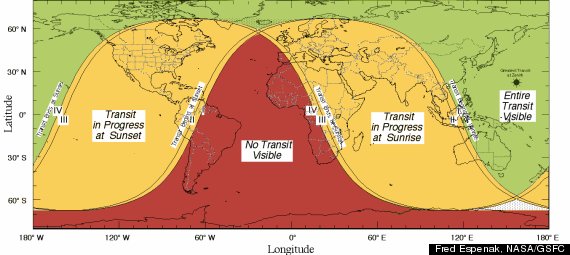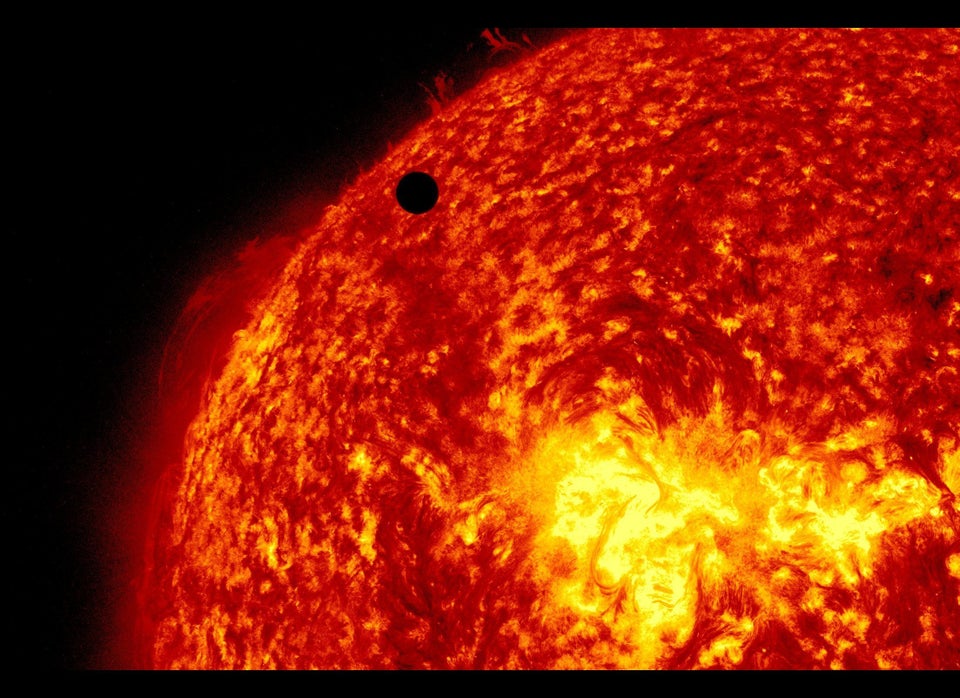
Today, Venus will cross in front of the sun, a rare phenomenon known as the transit of Venus and an event which will not occur again for more than 100 years.
"Venus...gets directly between the sun and the Earth, so we see it literally moving across the face of the sun," Phil Plait, the "Bad Astronomer" and author of Death From The Skies told The Huffington Post's Cara Santa Maria. "It's like a little, mini-eclipse."
For the many people around the world able to view it, the Venus transit will look like the sun is being punctured by a small black dot, according to NASA. As long as the skies are clear, people in all parts of the world except western Africa, southeastern South America, Portugal and parts of Spain will get to see part of the transit.
SCROLL DOWN FOR MAP
In the United States, viewers will be able to see the transit in progress at sunset on Tuesday, while those in Europe, east Africa, the Middle East, India and Australia will see it at sunrise Wednesday. Steven van Roode and François Mignard have created a customizable map that allows anyone to input a location to see where Venus will be visible in relation to the sun at a particular time, so click over to TransitOfVenus.nl to see the best local viewing times.
Attempting to view the sun directly during the transit of Venus without the right equipment can be dangerous, much like during a solar eclipse. But for those with the right tools, it will make for an awesome display.
To view the transit, NASA suggests using eclipse shades or a number 14 welder's glass. A telescope with a special type of solar filter can also be used.
A less expensive option is to build a pinhole projector, but because Venus is so small relative to the sun, "[s]mall features like the halo around Venus will not likely be discernible," according to NASA.
Finally, you can project an image of the transit using binoculars, a process for which directions are available at The Exploratorium.
If it's cloudy, you live in a place where the transit is not visible or you just want to see a really awesome view of the event, NASA will be hosting a live webcast of the transit from a telescope based in Hawaii. The webcast begins at 2:45 p.m. PDT/5:45 p.m. EDT.
For more on the transit of Venus, check out Cara Santa Maria's conversation with Phil Plait and click here to learn about the historical significance of the transit.
If you're an amateur astronomer who plans on bringing out the telescope for some skywatching this Tuesday, send us pics of your rig and the transit! We'll be collecting user photos from all over, and yours may be featured.
Upload your photos to our Facebook page, tweet them to @HuffPostScience, or email them to us at transitofvenus@huffingtonpost.com.
LOOK: Map of where the transit of Venus will be visible from the ground:

Clarification: An earlier version of this post indicated that the transit would occur on Tuesday evening. While it will certainly occur in the evening before sunset, the transit will be visible in the continental U.S. on Tuesday afternoon.
By submitting an image you are granting The Huffington Post a gratis perpetual license to use your image on its Huffington Post Science page(s). Further, by submitting an image, you represent and warrant that use of the image by The Huffington Post will not violate the rights of any third party and that you have the right and authority to grant these rights and license.
